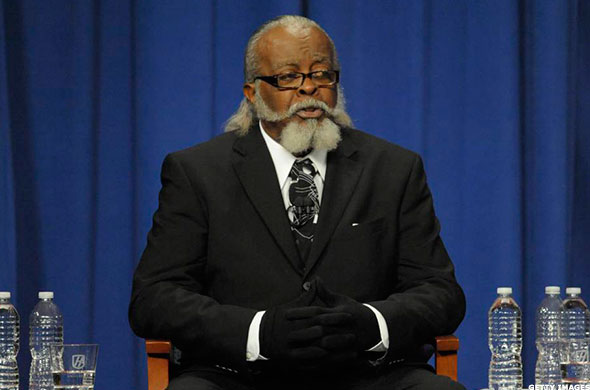Note: Updated with more comments.
NEW YORK (TheStreet) -- "The rent is too damn high!" is the battle cry (and name of the political party) of Jimmy McMillan, the kooky New York activist and sometime mayoral candidate. By contrast, Tuesday's release of the March data for the Case-Shiller Housing Index suggest that housing sale prices are flat, down 0.08% for the month. So is housing steady or out of control?
According to a new report from the National Low Income Housing Coalition, it turns out that McMillan is right about rent. Across the country, it's painfully expensive.
 On Monday, the affordable-housing nonprofit NLIHC released a study about how much money it takes to rent a market-rate apartment in the U.S. The results were dismal. The average American renter earns $14.64 an hour, according to the study. But on average it takes $18.92 an hour for a worker to pay for a two-bedroom house or apartment rental. That's a 52% increase since 2000. The average worker fares poorly in light of this study. But the minimum-wage worker is worse off by far. Minimum wage is $7.25, although Congressional Democrats are seeking to raise that to $10.10. The NLIHC found that by pooling their resources, two minimum-wage workers still wouldn't be able to afford a two-bedroom rental on their own. Even with the proposed minimum-wage increase, a single worker couldn't afford a one-bedroom alone, except in Arkansas, Kentucky or Puerto Rico. More than 40 million Americans rent, or about 35% of American households. 25% of renters have extremely low income. According to Sheila Crowley, the president of the NLIHC, "Three out of four extremely low income households have to spend more than half of their income on housing costs." So why does the Case-Shiller Housing Index show a slight drop in prices? That seems to suggest that inflation is under control and that prices are stable. And yet rents are up. It's less mysterious than it seems, said Claudia Coulton, Distinguished University Professor at Case Western Reserve University and co-director of the Center on Urban Poverty and Community Development there. Coulton said, "The single family home market, which is what Case-Shiller indexes, is still soft following the foreclosure crisis and tight credit situation. There are too many homes on the market in many regions along with too few qualified buyers." So the home sales market is languishing. If people can't afford to buy, what then? "Many of those individuals, who may have been home owners or first time buyers before in past years, are now flooding the rental market, making supplies tight," Coulton said. "Rental property owners are taking advantage of the situation to get increased rents. For low income households, this problem is unlikely to change much in the short run unless there is an increase in housing subsidy or low income rental housing programs." There is a disconnect between home ownership and renting in terms of affordability. Renters can't afford to buy, and the glut of renters has driven prices up drastically. Yet employment and wages have stagnated. Follow @NoTicker
On Monday, the affordable-housing nonprofit NLIHC released a study about how much money it takes to rent a market-rate apartment in the U.S. The results were dismal. The average American renter earns $14.64 an hour, according to the study. But on average it takes $18.92 an hour for a worker to pay for a two-bedroom house or apartment rental. That's a 52% increase since 2000. The average worker fares poorly in light of this study. But the minimum-wage worker is worse off by far. Minimum wage is $7.25, although Congressional Democrats are seeking to raise that to $10.10. The NLIHC found that by pooling their resources, two minimum-wage workers still wouldn't be able to afford a two-bedroom rental on their own. Even with the proposed minimum-wage increase, a single worker couldn't afford a one-bedroom alone, except in Arkansas, Kentucky or Puerto Rico. More than 40 million Americans rent, or about 35% of American households. 25% of renters have extremely low income. According to Sheila Crowley, the president of the NLIHC, "Three out of four extremely low income households have to spend more than half of their income on housing costs." So why does the Case-Shiller Housing Index show a slight drop in prices? That seems to suggest that inflation is under control and that prices are stable. And yet rents are up. It's less mysterious than it seems, said Claudia Coulton, Distinguished University Professor at Case Western Reserve University and co-director of the Center on Urban Poverty and Community Development there. Coulton said, "The single family home market, which is what Case-Shiller indexes, is still soft following the foreclosure crisis and tight credit situation. There are too many homes on the market in many regions along with too few qualified buyers." So the home sales market is languishing. If people can't afford to buy, what then? "Many of those individuals, who may have been home owners or first time buyers before in past years, are now flooding the rental market, making supplies tight," Coulton said. "Rental property owners are taking advantage of the situation to get increased rents. For low income households, this problem is unlikely to change much in the short run unless there is an increase in housing subsidy or low income rental housing programs." There is a disconnect between home ownership and renting in terms of affordability. Renters can't afford to buy, and the glut of renters has driven prices up drastically. Yet employment and wages have stagnated. Follow @NoTicker
No comments:
Post a Comment